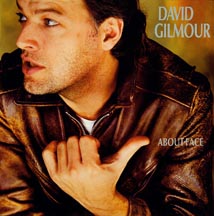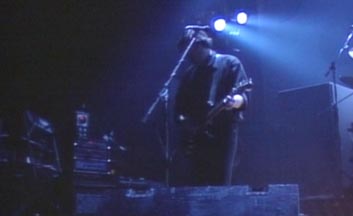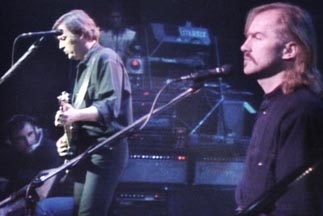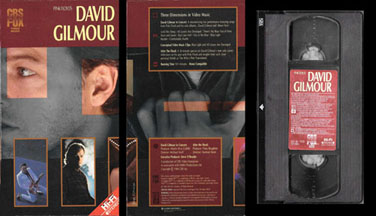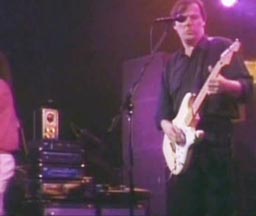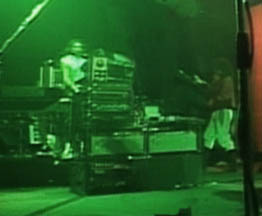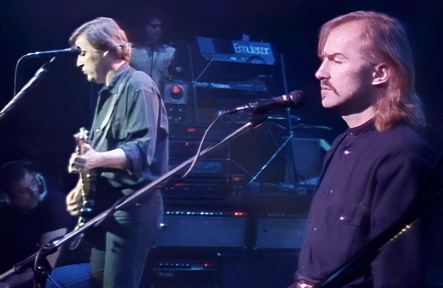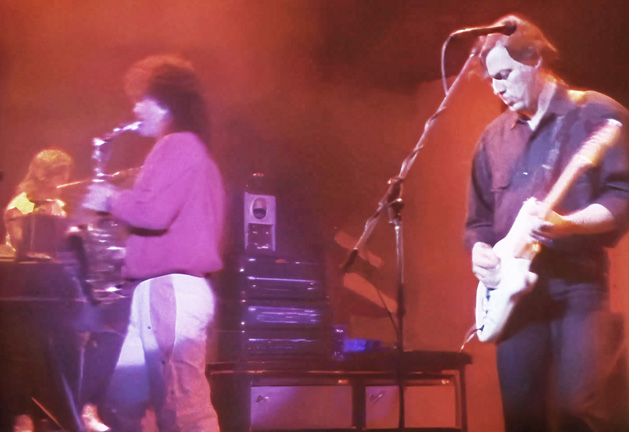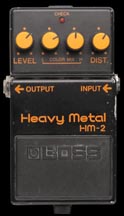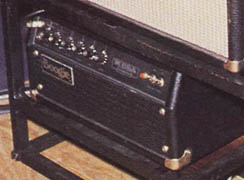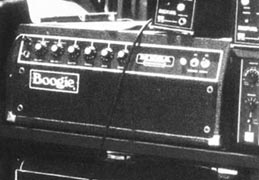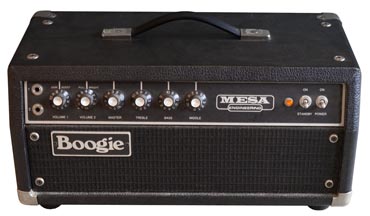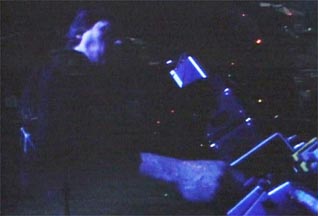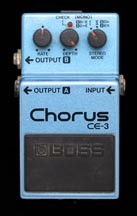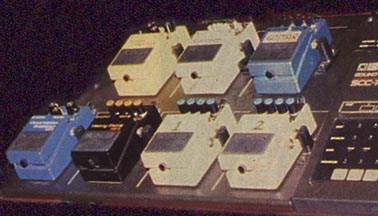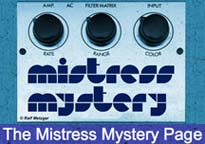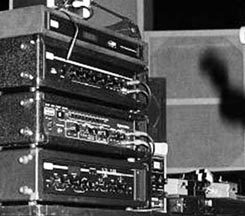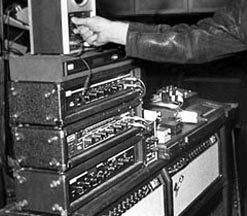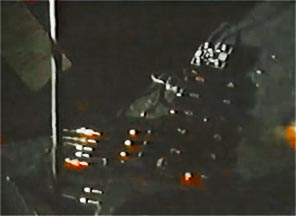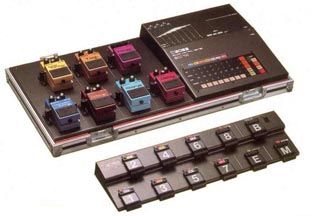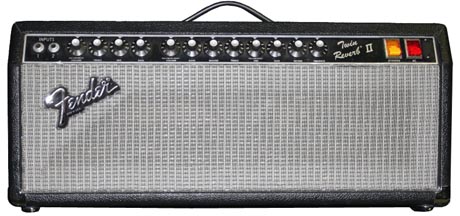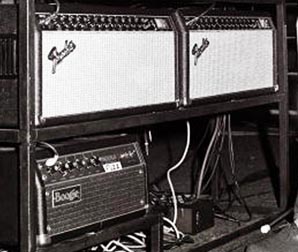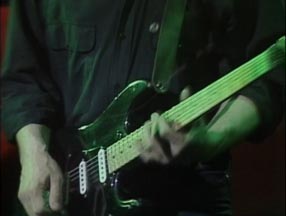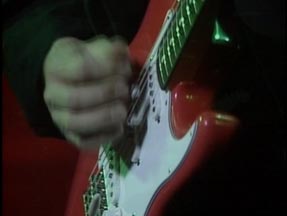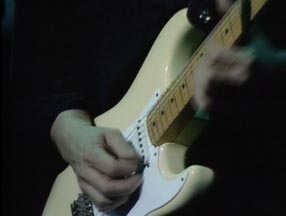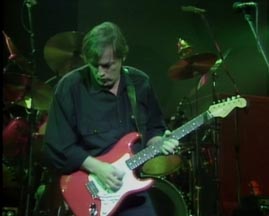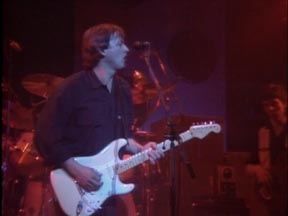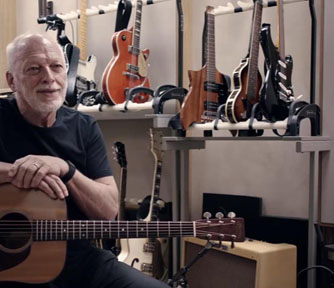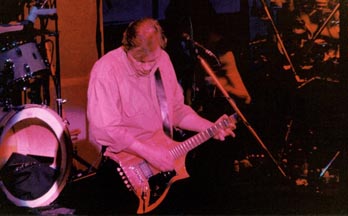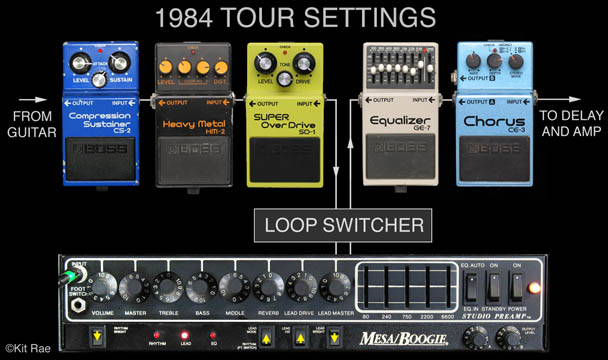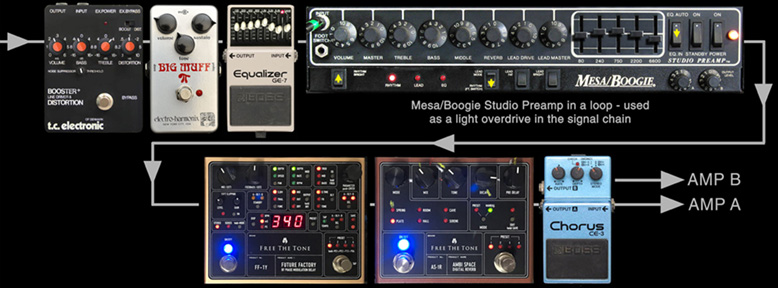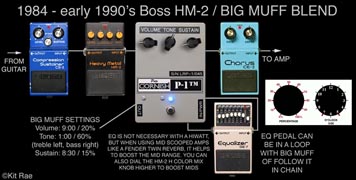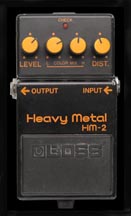NOTE: This website is frequently updated. Last update March 2024
"There are times when he has run a Big Muff into various things such as a Boogie head ... or added a graphic equalizer, etc. That’s the thing with David. He’ll have a certain sound in his head, and he’ll tweak his gear to find it. He just has this ability, and he always knows." —Phil Taylor, David Gilmour's Backline Tech
After David Gilmour's brief work in 1982 on the last Pink Floyd album, The Final Cut (which was more or less Roger Waters' first solo album), he did session work on Atomic Rooster's Headline News album. Following that he completely changed his gear and sound for his second solo album in 1983-84, About Face, and the subsequent tour. The 1980s through the early 1990s were a period that saw David working constantly as a session guitarist, making guest appearances on dozens of other artist's recordings. Among the many musicians David worked with were Roy Harper, Pete Townshend, Bryan Ferry, Paul McCartney, Peter Cetera, Kate Bush, Supertamp, Warren Zevon, Arcadia, Rod Stewart, and Berlin. His sound varied throughout this period, but there was a commonality to the tone of many of his guest solos, as well as new and unique aggressive playing style that utilized a lot of harmonics. This was the period where I first started to really get into Pink Floyd and David Gilmour guitar tones. I spent a lot of time researching and experimenting, trying to figure out what gear he used, how he used it, and studying his unique harmonic picking technique.
The effects used in this period varied, but there was some common gear in David's rig - the Boss HM-2 Heavy Metal pedal, a Mesa/Boogie amp head used as an overdrive pedal, a Boss SD-1 Super Overdrive, digital delays, Boss chorus, and Fender amplifiers. The key to many of David's high gain lead tones was no longer the Electro-Harmonix Big Muff into Hiwatt and rotary speaker amplifiers, as it was on Animals, David's first solo album, The Wall, and The Final Cut. Now it was mostly a blend of a Boss HM-2 Heavy Metal pedal with the Mesa/Boogie amp head into the Boss chorus. Mesa Engineering was a small company owned by Randall Smith, one of the first "boutique" hand-made amp builders, and the Boogie was one of the first cascading gain stage amplifiers. It was a very popular amplifier among top guitarists at the time, such as Carlos Santana, and Keith Richards of the Rolling Stones. Mesa went on to become a huge company, but back then these amps were made-to-order. David often used an early 1977-78 model Mesa/Boogie Mark I amp head. It was first seen in his live rig for The Wall concerts in 1980-81. The Boogie and fuzz pedal blend made for some incredible guitar tones. The way David used the Boogie in his signal chain was unique (as described below). The Boss chorus and digital delays were also essential elements of these tones.
Not much is known about the gear used for the About Face recording sessions. David began making demos in early 1983 then recorded sessions in Paris beginning in July 1983 and later in England. Most of the tracks were cut live with a full band, with additional multi tracking added later. David has stated he used a vibrato pedal for the synthesizer-like rhythm on Until We Sleep, running in time with the drum tempo. He also said he used a Rockman headphone amp for the outro solo on Blue Light, but that was only because he decided in the mixing stage to add a solo. He had no amplifier in the studio, so he plugged the Rockman straight into the mixing board. The Rockman was a miniature solid state amplifier simulator designed by Tom Scholz (of the band Boston) in 1982. It included two clean modes and distortion tones, along with a built in stereo chorus and echo. It could be played using headphones or plugged directly into a mixing board.
Based on the About Face guitar tones, David was going for a completely different sound than his last few Pink Floyd albums. I think I hear the Electro-Harmonix Big Muff and Mesa/Boogie distortion in a few places. The Boss HM-2 was not released until October 1983, so it is unlikely that it was used on About Face. It could have made it on David's pedalboard very late in the sessions, and parts of the Murder outro solo do sound like an HM-2 to me. The Black Strat was used on the Let's Get Metaphysical instrumental, which sounds like the Big Muff + Mesa/Boogie Mark I overdrive blend to me. The power amplifiers used probably varied, as on previous Pink Floyd sessions. Likely small Fender combos, the Hiwatt SA212, and David's Mesa/Boogie Mark I.
For guitars, David has stated he used his Martin D-35 acoustic, his old Black Strat, his "Workmate" Fender Esquire, along with several other guitars. The Black Strat was fitted with a Seymour Duncan SSL-1 bridge pickup, Charvel 22 fret maple neck, and a new Kahler tremolo system installed in early 1983. It was also around this time that David had the tremolo arm shortened to fit into the palm of his hand when playing. This mod, combined with the Kahler's capability to keep all strings in tune when using the whammy bar, created a whole different dynamic for David's tremolo sound.
THE ABOUT FACE TOUR RIG - The About Face tour in support of the album lasted from March - July 1984. The April concerts at the Hammersmith Odeon in London were recorded on video and released on VHS as David Gilmour in Concert in 1984. There is also a very good soundboard recording of the Westwood One Radio Network FM broadcast of the July 12th concert in Bethlehem, Pennsylvania. There are also several good auidience recordings, such as June 8th in Chicago, Illinois, June 26 in San Francisco, California (usually called New Game), and May 30th in Pennsylvania.
Many Gilmour fans did not like the newer songs or guitar tones from this tour as much as his previous work, but this was the only tour where David played some of the songs from his first solo album. In my opinion, the way the sound of this new rig was setup did not allow the expressiveness of David's playing to come through as well as it did on prior or later tours, but it was a totally unique sound and style of playing. I found the way David used this setup for his guest solo work on other artist's records from this era much more interesting, as the sound evolved and became more refined after the tour.
I still enjoy listening to the 1984 concert recordings, especially David Gilmour In Concert, even though there was a lot of "sameness" to the lead sound and playing, the chorus sound was a bit excessive, and the guitar solos often felt overlong. David was definitely into playing very long solos in this period! However, there was some stellar playing, and David's delay and modulation sound on Short and Sweet and Run Like Hell were heavenly. Short and Sweet had a fantastic, gritty and liquidy, modulated overdrive tone - like the crashing rumble of thunder made into music. I was obsessed with that tone, and got something close at the time, but I never really nailed it until I tried exactly what David used - a Boss HM-2 + Mesa/Boogie for the overdrive, and Boss CE-3 for the flange-like chorus, and a Fedner Twin Reverb.
Below are various guitar sections from a few excellent recordings of Gilmour's 1984 concerts.
![]() Gilmour Guitar Medley - July 12th, 1984 - Part 1
Gilmour Guitar Medley - July 12th, 1984 - Part 1
![]() Gilmour Guitar Medley - July 12th, 1984 - Part 2
Gilmour Guitar Medley - July 12th, 1984 - Part 2
![]() Gilmour Guitar Medley - April 30th, 1984 - Part 1
Gilmour Guitar Medley - April 30th, 1984 - Part 1
![]() Gilmour Guitar Medley - April 30th, 1984 - Part 2
Gilmour Guitar Medley - April 30th, 1984 - Part 2
![]() Gilmour Guitar Medley - June 8th, 1984
Gilmour Guitar Medley - June 8th, 1984
David Gilmour In Concert video snapshots from the Hammersmith Odeon in London, recorded in April 1984
David's Hammersmith Odeon rig, April 1984
According to David, the gear he used on his About Face album sessions in 1983 - guitars, amps, and effects - was completely different from the gear used for the subsequent tour. That may be, but I think the Boss HM-2+Mesa/Boogie was used on both. The tour gear consisted of Boss effect pedals, a Mesa Boogie amp head, MXR delays, and Fender Twin Reverb II amps. The speaker cabinets were WEM Super Starfinder 4x12s loaded with Fane Crescendos and Marshall 4x12 loaded with Celestions. The Marshalls were never clearly identified, but they appeared to be 1980s era JCM 800 Lead-1960 straight 4x12 cabs.
"I have two new 100-watt Fender Twin Reverb heads running to two 4xl2 cabinets each - two WEM cabinets with Fane Crescendo speakers and two Marshall cabinets with Celestions. I felt like a change in amps this time, and I tried out the new Fenders and liked them, so I thought I'd get a couple…" — David Gilmour from Guitar Player Magazine, November 1984
As stated, the Mesa/Boogie head was one key to the tones of this era. David had used the Boogie for light overdrive tones since 1978, inluding The Wall live rig. This time he ran the HM-2 into the Boogie head (placed the signal chain using the Slave output), with the Boogie used to smooth out the HM-2 tone. The Boss SD-1 was also used with the Boogie for leads on the tour. I think a Big Muff, or Big Muff + Boogie combo may have also been used for some songs on part of the tour. After the tour ended Gilmour described this exact setup in the November 1984 issue of Guitar Player magazine, just after he had used this same rig to record his fantastic guitar work for the Paul McCartney song No More Lonely Nights in October 1984.
"I'm using all different stuff from what I've used before, mostly Boss things. I'm also using a Boogie amplifier as an overdrive unit. I can just patch it in by using a footswitch on the pedalboard. I also have a couple of MXR DDLs. That's it, really. All standard stuff, all off-the-shelf gear" —David Gilmour from Gutar Player Magazine, November 1984
"At the moment the sound that I'm using a lot of the time is going through a Boss HM-2 Heavy Metal to a Boogie amplifier (set as an overdrive) to a DDL and then on into a regular Fender amplifier....I use a DDL on it - a little bit - most of the time, because I find it stops the fuzz box from from sounding like a fuzz box. It smoothes off the unpleasant, raw frequencies that you get from the fuzz box. Then you get a nice sort of sound. That's what the Boogie does as well." —David Gilmour from Gutar Player Magazine, November 1984
The Boss HM-2 Heavy Metal was David's lead distortion pedal for the 1984 About Face tour
THE BOSS HM-2 - The Boss Heavy Metal HM-2 may seem like an odd choice for Gilmour to use. The pedal was first released in 1983 and became a favorite among 1980s hair metal bands and Swedish death metal bands, but it was not strictly limited to playing metal. This was one of the first pedals I ever owned and I played everything but metal with it. It had a unique split-band tone stage. The color L knob added or removed bass bandwidth, and the color H knob added or removed mid range bandwidth. The mids could be completely scooped, even more so than a Big Muff, or completely boosted. Unfortunately, the HM-2 lacked any control over the treble range, and by itself the distortion can be a bit harsh. When blended with certain slightly overdriven amps however, like the Mesa/Boogie, the combination made a smooth high gain lead tone. Below is a clip demonstrating just the HM-2 sound.
Boss HM-2 Demo - Strat with SSL-5 bridge pickup and Fat 50s neck pickup through a Reeves Custom 50. Effects use are a Boss CS-2 compressor, Deluxe Electric Mistress, Boss CE-2 chorus, FTT Future Factory delay, and FTT Ambi Space reverb.
THE BOSS SD-1 - The iconic Boss Super Overdrive SD-1, released in 1981, was the only other high gain effect in this rig. It was an improved version of the original Boss OD-1 overdrive from 1977, only with a tone circuit added. That tone circuit was very similar to the one in the Ibanez Tube Screamer, giving the SD-1 a very similar sound as the TS. It has a bit more low end and a bit more dirt in the distortion, and in my opinion, sounds better than a TS. While the TS has gone through numerous changes over the years, the SD-1 has remained basically unchanged in production for over 35 years (still available at the time I wrote this). Photos show it was set with the drive at maximum and tone knob at nearly maximum. When blended with the Boogie head it created a very bright lead tone, similar to the HM-2, but with brighter mid range and treble.
The Mesa/Boogie Mark I from David's 1984 rig. The Boogie was a 2 channel amp, but not footswitchable. Input 2 is a relatively clean channel, similar to an early Fender Blackface amp, but it can be dialed into light overdrive. Input 1 is the high gain channel, wired in series with input 2, and used for anything from light overdrive to high gain blistering distortion. David plugged into the high gain channel input 1, as he did with The Wall rig in 1980-81, with settings set for overdrive.
THE MESA-BOOGIE MARK 1 - As stated, the Mesa/Boogie Mark I head did not power a speaker cabinet in David's rig. It was used strictly as rack effect in the signal chain, no different than an overdrive or fuzz pedal, and David's settings indicate it was set for a light drive/fuzz tone. The first time David was seen using it this way was in his 1980-81 rig used for The Wall tour, where he used the Boogie to privide a little distortion for a few songs. A line out after the fuzz and distortion pedals was sent to the Mesa/Boogie Input 1. The Slave line out from the back of the Boogie returned the signal to the signal chain before the delays and modulation effects. In essence, it was just another pedal in the signal chain. After the modulations and delays, the signal was then fed to the primary power amplifiers as usual - typically Fenders. Since a speaker cabinet was not used with the Boogie, the speaker jack was plugged into an 8ohm load resistor to prevent damage to the power tubes and output transformer. Some Boogies were also made with an optional graphic equalizer for tone sculpting, but David did not have that option on this model. A Boss GE-7 EQ pedal was used after the Boogie in the signal chain to fine tune the tone. There is no confirmation if the Boogie was placed before or after the Boss distortions in the tour rig, but David said in one 1984 interview that he was running the HM-2 into the Boogie at the time.
(left) David adjusting a Boss pedal. (middle) Boss CE-3 stereo chorus. (right) David's pedal board included the following effects:
(top row) Boss SD-1 Super Overdrive, Boss GE-7 Equalizer, Boss CE-3 chorus
(bottom row) Boss CS-2 compressor/Sustainer, Boss HM-2 Heavy Metal, Boss DD-2 Digital Delay, Boss DD-2 Digital Delay
THE BOSS CE-3 - The Boss CE-3 stereo chorus was probably the most essential element of David's 1984 tour sound. It was very prominent effect in almost all the songs. The CE-3 sound was very different than the Boss CE-2 chorus David used for The Wall concerts. It worked perfectly through darker (mid-scooped) amps like the Twin Reverb and distortion pedals like the HM-2 or Electro-Harmonix Big Muff. When using David's settings, the CE-3 sound had more in common with an Electric Mistress flanger than a chorus. Since the MXR delays David used were not stereo effects with separate L and R channels, the CE-3 was placed last in the signal chain to utilize its stereo outputs. The left and right channels were each sent to one of the two Twin Reverbs.
The CE-3 was an analog chorus made by Boss from 1982-1992. It included two switchable stereo modes. Mode I sent the chorused signal to Output A, and a 180° phase inverted chorus signal to Output B. This created a wide depth to the chorus sound when using two amps, and that is the mode David used. Mode II sent the chorused signal to Output A and the dry signal to Output B. This created a slightly less chorus effect, but retained the wide stereo field separation when using two amps.
To replicate the 1984 tour sound correctly, set the CE-3 Rate knob around 12:00, the Depth knob around 3:00, and set the Mode knob to position I. For the heavier, flange-like sound used on Run Like Hell and Short and Sweet, set the Depth to maximum.
A Big Muff can be seen on the pedal board in some photos shot in the rehearsal prior to one of the April concerts, but it does not appear to be on the board in the concert video taped on April 30th for MTV's David Gilmour in Concert broadcast and VHS release. Perhaps David was trying it out in this rig and decided not to use it.
The rack effects were all MXR. At the top of the rack was an MXR Pitch Transposer and Pitch Transposer Display. Based on the official recordings and bootlegs, David only used the MXR Pitch Transposer for the solo at the end of Until We Sleep. For delays David had an MXR 113 Digital Delay System and MXR Digital Delay System II in his rack, which were the primary delays. The reason David used multiple delays was to set each for a different delay time setting for specific songs. He could also adjust delay times on-the-fly during shows.
The MXR 113 was released in 1976. David had been using one since the Animals tour in 1977. It had a warm high end roll off on the repeats, similar to David's Binson Echorec. It also had delay width and frequency knobs in the Sweep section allowed you to add some chorus, vibratto, and flange effects, which I don't think David used. It had a maximum delay time of 320ms, but could be expanded to 1280ms by adding additional memory chips. The MXR Digital Delay System II was an upgraded version of the 113 that showed the delay time in milliseconds on the front panel and featured additonal fine tuning controls. It had a similar Sweep section chorus and chorus and flange effects as the 113, but again, I don't think David used those effects. It had a maximum 16kHz bandwidth up to 800ms, with a maximum delay time of 1600ms, expandable to 3200ms. These were state of the art delays at the time, but were rather noisy effects compared to modern digital delays.
MXR Digital Delay System II showing David's knob settings
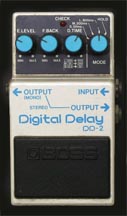
The famous Boss DD-2 from 1983, the first compact digital delay pedal, capable of delay ranges from 12.5ms-800ms
David's pedal board also had two new Boss DD-2 digital delays on it. The DD-2 was released in 1983 and was the first compact digital delay pedal. It was a big jump in technology at the time. Roland had huge success with their SDE 3000 rack delay, and somehow had managed to miniaturize that delay chip to fit into a compact pedal. The 7KHz high-frequency roll off of the DD-2 made it sound like something in between an analog and digital delay. It was capable of delay ranges from 12.5ms-800ms and included a delay output jack and a dry output.
The 12 bit sample rate repeats of the DD-2 were pristine sounding for the time, but not perfect, which made them perfect for David. They provided the more clear, accurate repeats for songs like Run Like Hell, and the MXR delays provided warmer repeats with the Echorec-style high end roll off.
"I change my echo settings fairly often in concert. I have two (MXR) units, and I have different echo settings on both. There are times when I have both running at the same time for certain effects. I usually try, in solos, to set the DDLs to have some rhythmic time signature in common with the tune. Because the notes all intertwine, it doesn't matter anyway, but I find that I usually set them on a triplet. It's a sort of melodic delay to use." - David Gilmour from Guitar Player, November 1984
I just got one of the new Roland (Boss) DD-2 footpedal digital delays. It's very, very good, and it goes right on the pedalboard" — David Gilmour from Guitar Player Magazine, November 1984
"I use the MXR Digital Delay. I use one of their old ones most of the time because the (band)width is narrower. If you get too high a quality bandwidth on a DDL you hear too much pinging and lose the sort of echo effect I use it for. Some are actually too high quality for my personal taste." - David Gilmour from Guitar magazine, January1985
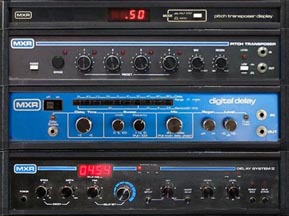
David Gilmour rack effects (left) and his effects rack from April 1984 (right).
Rack Effects - top to bottom
MXR Pitch Transposer Display
MXR Pitch Transposer
MXR 113 Digital Delay System
MXR Digital Delay System II
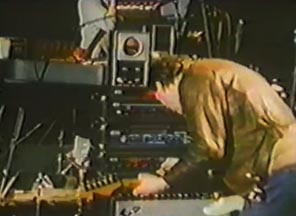
David Gilmour adjusting his MXR rack effects from April 1984. Note the Boss pedal board on the right includes an Electro-Harmonix Big Muff, but it does not appear on the board in the April 30th concert that was video taped for the David Gilmour in Concert VHS.
David's Boss SCC-700C foot switcher (left), and a Boss SCC-700 system (right). The four-switch box to the right of the foot swticher board (left photo) was a preset selector for the MXR Pitch Transposer.
Everything was run through a Boss SCC-700 pedal board system, which David would use for the next three years. It was one of the first production made programmable effects switching systems on the market, replacing David's Pete Cornish custom pedal board used for The Wall shows. Any effects connected could be programmed to switch on in any order. Even with that, David found the system lacking for what he needed and added a separate, smaller effects switching pedal board to the rig for delay and volume pedal switching.
"I've got the Roland (Boss) SCC-700 pedal board system with a bunch of effects on it. You don't have to use just the ones on the board; you can run out to all sorts of other things... I found it too inflexible, so the last send and return on it goes to a separate little box, which is connected to my DDLs and a Pete Cornish volume pedal; it's just a simple pot in a pedal. I put that in last on each of my presets, in addition to any of my other presets. That way, I can switch my volume pedal and two DDLs in and out separately from the presets." - David Gilmour from Guitar Player, November 1984
David's 1984 rig included new 1983 Fender Twin Reverb II amplifiers and a 1977 era Mesa/Boogie Mark I, likely the same one from The Wall live rig. Note the FUZZ label added on the Boogie, even though David said it was used as an overdrive.
The signal from the effect rack was sent to two brand new Fender Twin Reverb II amplifiers for stereo. The Twin Reverb II was a Paul Rivera era design, made from 1983-1986. It was a different circuit than the older Fender Twin Reverbs or Showman amps David had used in the past. The Reverb II's clean tone was voiced like a mid-scooped Twin, but it also had an overdrive stage that sounded a bit like a Mesa/Boogie, something common in the Rivera era designs. The II also had a fairly extreme mid range boost, although photos showing David's settings indicate he only had the mids knob set to arund 3. These particular Twins were probably used primarily because of the Fender clean tone. An extra Twin II was in the rack as a spare, along with the previously mentioned Mesa/Boogie Mark I. The signal went from the Twins to two WEM 4x12 cabinets with Fane Crescendo speakers and two Marshall 4x12 cabinets with Celestion speakers.
For the tour guitars, David used a 1976 Ovation Custom Legend acoustic, a Washburn solid-body acoustic, two new Fender vintage reissue guitars, a Roger Giffin custom headless guitar, and the old, heavily modified, Black Strat. It now included a Seymour Duncan SSL-1 bridge pickup, Charvel 22 fret maple neck, and a Kahler tremolo system installed in early 1983. It was tuned to Dropped D (low E changed to D) to play Short and Sweet, and Run Like Hell.
The floundering Fender company was recently bought from CBS by the employees and re-organized. They had just made a line of high quality vintage reissue Stratocasters, supposedly made to vintage specs. They were not, but the build quality was far better than the previous Fenders under CBS ownership, so in January 1984 David went to the CBS Fender UK warehouse in Enfield, Middlesex, and picked out several new reissues to use on the 1984 tour. The Strats were delivered in two batches. The first included a cream colored '57 reissue Strat with a maple neck, which was his main guitar for the tour, a fiesta red '62 reissue Strat with an ebony neck, a Stratocaster Elite, and a 52V Telecaster. The Strats were set up and had the tremolo arms shortened so David could hold them in his palm while playing.
Three of the 1984 tour guitars (left to right): The old, heavily modified Black Strat (tuned to Drop-D) with Kahler tremolo and 22 fret neck, a reissue '62 fiesta red Strat, and reisue '57 cream Strat. All had the shortened tremolo arm modification.
A custom headless guitar used briefly on the 1984 tour, made for David by famed luthier Roger Giffin
GETTING THE TONES - Below are my settings for replicating David's lead tones for the 1984 tour. The key ingredients are the Boss HM-2 + Mesa/Boogie and Boss CE-3 chorus through a Twin Reverb. I believe David also used the Boss SD-1+ Mesa/Boogie and Boss CE-3 for some solos. The CS-2 compressor and GE-7 equalizer are not necessary, but they do help fine tune tone the tone. A digital delay is also necessary for this sound. I use an old Boss DD-2 or TC Nova delay. David used various delay times for his solos, usually 440ms to 480ms, with 7-8 repeats. The repeat volume varied depending on the song.
For the chorus, a Boss CE-3 is a must, especially if you want to run a stereo rig using the two outputs (Mode 1). The flange-like chorus of the CE-3 really is a key to the '84 tour sound. A Boss CE-2, or one of the later Boss chorus pedals, will also work for a mono setup, but there is a characteristic of the CE-3 modulation that is very distinct. The CE-2 has a much brighter mid range than the CE-3, and requires completely different settings for a similar sound, but it really cannot sound like the CE-3.
You can use a Boogie Mark I, II, or III (using the Slave/Direct Output, rhythm channel set for a light overdrive) with a dummy load on the speaker output, or a simpler option is the Mesa/Boogie Studio Preamp, which does not require a dummy load. The Studio Pre was based on the Mark IIC design, has similar controls as the IIC/C+, and the clean channel sounds like an early 1970s Fender blackface (or early silverface) amp. It can be plugged into your signal chain just like a pedal using the INPUT jack on the front and MAIN Signal Output on the back. Connecting it to your signal chain using a simple loop switcher will allow you to switch it in and out of the chain when needed. I show the Boogie after the Boss distortions in my signal chain below, but it also works before the distortions.
Below are sound clips of my rig using a Fender Stratocaster with single coil pickups and a Fender Twin Reverb amp.
1984 Setup - Boss CS-2 Compressor > Boss HM-2 > Mesa/Boogie Studio Preamp > Boss CE-3 chorus > MRX Digital Delay II
1984 Tone Building - Mesa/Boogie Studio Preamp first, then HM-2, then Boss CE-3, then MRX Digital Delay II.
1984 Setup - Boss CS-2 > Boss HM-2 > Mesa/Boogie - raw tone with no chorus
If you don't have a Boogie you can still get a similar sound with just the HM-2 and CE-3, but it will be missing an essential part of the tonal voice and characteristic of the distortion.
SETTING UP THE STUDIO PREAMP - I run the Mesa/Boogie Studio Preamp through a loop switcher on my pedal board. It is placed after the high gain effects in the signal chain, and before the modulations and delays. I leave the Mesa on all the time and when I want to use it, I just hit the loop switch to bring it into the signal chain as if I were switching an overdrive pedal on and off.
The looper line out goes to the front input of the Mesa, or the Instrument input on the back. I use the MAIN Signal Output on the back of the Mesa to return the signal to the looper. You can use the Recording outputs too, but Mesa EQ'd the tone on those outputs in a way that I do not like. With the rhythm channel engaged, the Master pot is a master volume for the rhythm channel. The main Volume on the left is kind of a gain pot for the rhythm channel, which is why I usually have it on 10 to get some overdrive. The small Output Level (A & B) pots on the front control the overall level being sent form Main Outs A & B (or Recording Outs A & B) back to the pedal board. You can set the Output pot high and the others low, vise versa, or all in between. It just depends on the amount of drive and noise you want. Once you get the level to unity, the Master pot can be used to fine tune it.
LET'S GET METAPHYSICAL - The clip below is a blend of the studio album sound and the live sound with the Mesa/Boggie in the signal chain. I used a Strat with an EMG-SA active bridge pickup and the SPC control on maximum, but regular single coil pickups work just as well. The signal chain is TC Electronics Booster+Line Driver & Distortion (BLD) > EHX Ram's Head Big Muff > Boss GE-7 EQ > Mesa/Boogie Studio Preamp set for overdrive > FTT Future Factory delay (340 ms) > FTT Ambi Space plate reverb > Boss CE-3 chorus using the A and B outputs to two different amps - 59 Fender Bassman (left channel) and Fender Twin Reverb (right channel).
The TC BLD is only used to add a slight punch before the muff, but you can also use a compressor like a Boss CS-2 or CS-3 instead to give the attack a bit more bite.
The video below is a blend of the studio album version and the longer live version with a full band. I demonstrate the Big Muff + Mesa/Boogie overdrive blend and the Boss HM-2+Mesa/Boogie blend later in the video. This is a stereo setup using the A and B outputs of the Boss CE-3 through a 59 Fender Bassman in the left channel and a Fender Twin Reverb in the right. The primary delay used was a Free the Tone Future Factory. A Free the Tone Ambi Space was used for plate reverb. Effect settings are the same as above. Mics used on the Bassman and Twin Reverb speaker cabs are Sure SM57 and Sennheiser e906.
The video below is the same, but with a tone build breakdown at the beginning. This illustrates what each effect adds to the overall guitar tone.
MY ALTERNATE 1984 LEAD SETUP - Most people are not going to buy an expensive Mesa Boogie Mark I, II, or III just to use as an overdrive in a setup like this, but it is very difficult to get these tones any other way. It took a long time for me to figure out the best alternative combo to closley duplicate these tones (without the Boogie). It is not likely a combo David used, but the setup is shown below - a blend of the HM-2 and a Big Muff Pi - works very well. Note that a Cornish Big Muff is shown (P-1), but any Ram's Head era Big Muff, or clone, should work. You can also try something similar with a ProCo Rat or Boss MZ-2. This setup works best with a clean Hiwatt type amplifier. If you use a mid scooped Fender amp, like a Twin Reverb, it is best to use an EQ pedal to boost the mid range. A Strat equipped with EMG-SA pickups, with the SPC control set about mid way, is perfect for these tones, but it sounds good with hot single coil pickups as well.
1984 SHORT AND SWEET and RUN LIKE HELL SETUP - I found a similar setup David used for the high gain lead tone was also used for Short and Sweet and Run Like Hell - the Boss HM-2 + Mesa/Boogie Mark I, II, or III (using the Slave/Direct Output, rhythm channel set for a light overdrive) or Mesa/Boogie Studio Preamp (using the MAIN Signal Output, rhythm channel set for a light overdrive). The HM-2 and CE-3 are the key ingredients, so if you don't have a Boogie you can still get a similar sound, but it will be missing that huge, low end growl.
For Short and Sweet set the delay 480ms (7-8 repeats, repeat volume level set around 75%), Boss CE-3 chorus (rate 50%, depth 100%), into a Fender Twin Reverb (reverb off). The modulation from the CE-3 is almost flange-like. Note that the CE-3 is very different than the Boss CE-2 that Gilmour used in later rigs. Setting a CE-2 with both knobs at 3:00 produces a similar sound as the CE-3, but the CE-2 has a much brighter mid range than the CE-3. A digital delay must be used to accurately replicate that huge, shimmery delay sound, preferably a DDL with a tone or bandwidth knob that allows the repeats to be set very bright. The MXR Digital Delay David used has a shimmery, white noise sound as repeats trail off. I use the TC Nova delay and set the Color knob 100% on the digital side, which accurately reproduces that sound. A Boss DD-2 or DD-3 also works.
This setup also requires a Strat with a tremolo arm, as David rocks the arm after he plays the big sustained chords to create the wavy, modulated "wobbles" in the delay. He used his Black Strat tuned to dropped D (low E string tuned to D), and plays using the same D and Dm chord shapes as used in Run Like Hell. This makes sense as both songs were written around the same time. Similar chords are also used on the Sheep outro from Pink Floyd's Animals album. My pedal and amp settings are shown above. I use the Mesa/Boogie Studio preamp instead of my Mark III, as it is much easier to setup in the signal chain. If you do this, place the Boogie in a loop switcher between the distortion/drive pedals and the chorus/delays, so you can switch it on and off like an overdrive pedal.
Below are sound clips of this setup through my rig using a Strat tuned to drpped D into a Twin Reverb. This is the signal chain: Strat bridge pickup (hot Seymour Duncan SSL-5) > Boss HM-2 > Boss CE-3 > Mesa/Boogie Mark III (or Studio Preamp) > TC Nova Digital Delay > Fender Twin Reverb. The Mesa/Boogie was set for a slightly dirty Fender blackface era tone using the rhythm channel. The first clip is a tone breakdown, turning each effect on in this order: Twin Reverb clean sound, Mesa Boogie rhythm channel, Boss HM-2, Boss CE-3, TC Nova Digital Delay.
A similar setup was used for Like Hell in 1984, but without the Mesa/Boogie rhythm channel. Just use the HM-2 and CE-2, with the guitar volume dialed down slightly. The digital delay time was set at 380ms, with the delay repeat volume at 100%. This song is also in dropped D tuning. David may have also used the Boss CS-2 compressor, and in some bootlegs it sounds like the Mesa/Boogie rhythm channel was used instead of the HM-2.
Kit’s Secret Guitar, Gear, and Music Page
Guitar stuff, gear stuff, soundclips, videos, Gilmour/Pink Floyd stuff, photos and other goodies.
Copyright Kit Rae.
VISIT MY SWORDS, KNIVES and FANTASY ART WEBSITE www.kitrae.net

